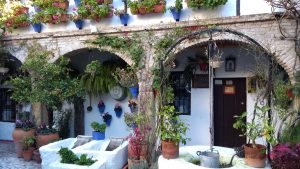 We completed our Workaway assignment on Friday, January 26th and were on the road to Córdoba by early afternoon. As it was only a 3.5 hour drive we arrived in plenty of time to find our hotel and park the car before dark. We had booked a hotel in the old historic part of town again which meant there was no place to park the car at the hotel. Roy seems to have gotten very skittish about driving on narrow streets so he dropped me off a block or so away from the hotel while he went to look for parking. We had arrived in Córdoba in the midst of one of their festivals and the police had closed streets and bridges and generally made parking a long drawn out affair. Córdoba has a lot of festivals. One that we heard of was the festival of patios in May. There was even a patio museum there which was just one patio but it was decorated beautifully!
We completed our Workaway assignment on Friday, January 26th and were on the road to Córdoba by early afternoon. As it was only a 3.5 hour drive we arrived in plenty of time to find our hotel and park the car before dark. We had booked a hotel in the old historic part of town again which meant there was no place to park the car at the hotel. Roy seems to have gotten very skittish about driving on narrow streets so he dropped me off a block or so away from the hotel while he went to look for parking. We had arrived in Córdoba in the midst of one of their festivals and the police had closed streets and bridges and generally made parking a long drawn out affair. Córdoba has a lot of festivals. One that we heard of was the festival of patios in May. There was even a patio museum there which was just one patio but it was decorated beautifully!
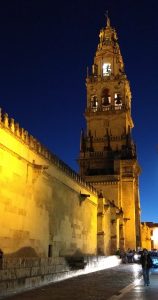
Our hotel was just across the street from the backside of the Mosque/Cathedral also known as the Mezquita. It is one of the world’s greatest works of Islamic architecture. Once inside the walls there is a courtyard of orange trees. There were so many oranges, they were floating in the fountains! This site has been used as a place of worship since the time of the Visigoths (5th to 8th centuries) and is an example of how people of different faiths can coexist in peace.
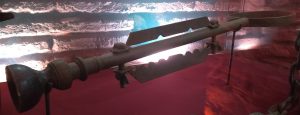
Afterwards we went to the opposite extreme and visited the museum of the inquisition. This place had quite an impressive display of torture devices but the overall affect was chilling and depressing. On a lighter note, check out this explanation of the punishment for drunkards who party too loudly (description). To cheer ourselves up we found a cool place outside the touristy old town that was a collection of restaurants all under one roof for a bit of lunch. Later, we went to an equestrian show of Andalusian horses. These horses belonged to the Royal Stables founded originally by King Felipe II in 1570.
Video of the Andalusian horses performing [youtube https://www.youtube.com/watch?v=r1jKRM4IiBM]
Sunday morning we set off through the heart of Andalucia for Gibraltar. We briefly stopped at one of the most famous of the white villages – Ronda. It seems every photo you see of Ronda shows a huge bridge over a deep gorge. We didn’t get that shot but it was such a unique town that we got other beautiful shots. There was a bicycle race through town that day and every few seconds the police would blow their whistle and a biker would could tearing down the street! If you ever get a chance to visit, take it. It is stunning!
We continued our drive towards Gibraltar and saw many of the white villages the area is known for. We had booked a hotel in La Linea de la Concepción. It was a less expensive place to stay than Gibraltar and that is the best thing I can say about it. It does have an interesting history though. It got its name “La Linea” because that was the line as far as the cannon fire from Gibraltar could reach. The town grew up just beyond the line. We had read that it was a good idea to park your car and walk across the border to Gibraltar as the lines at the border could be hours long. It really wasn’t necessary because of the time of day that we arrived. We got there late afternoon on a Sunday. Most of the shops were closed so we hired a cab for a tour of “The Rock”. 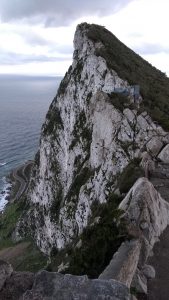
Interestingly, you have to drive across a runway to get into town. There are barricades like at rail crossings that come down about 10 min. before a flight is scheduled to arrive. I was thankful that we had left the driving to the tour operator as the roads were extremely narrow and steep. We got to see some of the Barbary macaques that live in the nature preserve. The view from the top of the drive was breathtaking even in the cloudy windy weather we were experiencing. You could see the Mediterranean on one side and the Bay of Gibraltar on the other side. We could also see Morocco to the south just a short ways. There were many ships in the bay and we learned that one of Gibraltar’s main sources of economic activity is ship refueling. Our tour guide told us that sometimes ships have to wait a week or more to be refueled. The fuel ships go out to the big ships in the bay to do the refueling.
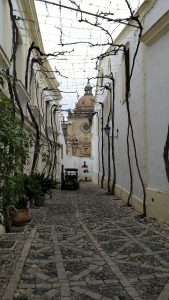
The next morning we resumed our drive by heading northwest to the ancient city of Cádiz. This city is considered to be one of the oldest continuously inhabited cities in Europe. It was founded by the Phoenicians over 3000 years ago. The drive was only about 1.5 hours so we arrived just in time for another cup of coffee. The weather was cloudy and windy but quite mild. We took a walk along the beachfront after our coffee before getting back in the car for the drive to Jerez.
There are many towns in this part of Spain that have “de la Frontera” as part of their name. This means that these villages were on the frontier of the area that was between the Moors and Christians in the 13th century. The names stuck. Jerez de la Frontera is well known for its production of sherry wine. In fact the name sherry is derived from the old name of Jerez, Xerez or Xerés. It was no problem finding a sherry producer to visit and tour. We visited the González-Byass bodega, producer of Tio Pepe sherry where we ended the tour with a tasting. According to the Guinness Book of World Records, the worlds largest weather vane is at the González-Byass winery.
We ended this busy day in Seville or Sevilla as its known here in Spain. The first thing we did after checking in to our hotel was return the rental car. So the next morning we tried one of those hop on and hop off bus tours. We had done that when first arriving in Barcelona and found it really helpful in orienting ourselves to the city. We found it not as helpful in Sevilla and started enjoying our time much more after hopping off. The Sevilla cathedral is said to be the world’s largest by volume and it is enormous! The only museum we visited was a small interpretation center of the Jewish quarter. It was well done, but another sad tale of persecution by the church and monarchy.
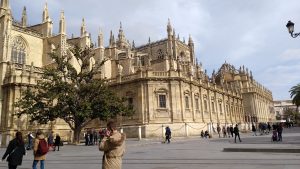
While walking around Sevilla I spotted a plaque in the sidewalk stating that Sevilla is the city of opera. I have since learned that more than 100 operas were set in Sevilla. We visited the University of Sevilla which is the old tobacco factory where Carmen worked. This woman’s story inspired Georges Bizet to write the opera “Carmen”.
The last evening of our little tour we went to a flamenco show. It was in a small venue where we were feet from the stage. The guitarist, singer and dancer performed many styles of flamenco. It was really well done. We weren’t in any of these towns long enough but especially Sevilla.
Wednesday morning we walked to the train station and got on the high speed train for Barcelona and were home in less than 6 hours.
Wow beautiful! Thanks for sharing.